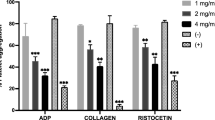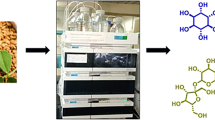Abstract
Capilliposide-A, a rare secondary saponin found in Lysimachia capillipes, has been reported to exhibit good biological activities. However, it is difficult to obtain a sufficient of capilliposide-A for further research through column chromatography and chemical synthesis. The aim of this work was to establish an efficient approach for the convenient preparation of this steroid saponin based on alkaline hydrolysis. The hydrolysis conditions were optimized by response surface methodology after a preliminary investigation of the affecting factors by single-factor experiments. Under the optimal conditions, the macroporous resin that adsorbed capilliposide-B and capilliposide-C was hydrolyzed in an 8% (w/v) NaOH solution at 35 °C for 65 h, and the yield of capilliposide-A was 68.90%. The results demonstrated that this newly developed approach is efficient for the preparation of capilliposide-A, and this approach is also crucial for further development and clinical applications.




Similar content being viewed by others
References
Tian JK, Xu LZ, Zou ZM, Gong MH, Yang SL (2006) Two new triterpene saponins from Lysimachia capillipes. J Asian Nat Prod Res 8:439–444
Zhang XY, Chen XZ, Jin J, Gong MH, He Q, Li XS, et al (2021) New determination method of two bioactive saponins in Lysimachia capillipes Hemsl. by quantitative analysis of multi-components by single-marker. J Chromatogr Sci 59:941–948
Liang B, Zhang L, Tian JK, Xu LZ, Yang SL (2006) Isolation and characterization of two new saponins from Lysimachia capillipes. Carbohyd Res 341:2444–2448
Xie C, Xu LZ, Luo XZ, Zhong Z, Yang SL (2002) Flavonol glycosides from Lysimachia capillipes. J Asian Nat Prod Res 4:17–23
Fei ZH, Wu K, Chen YL, Wang B, Zhang SR, Ma SL (2014) Capilliposide isolated from Lysimachia capillipes Hemsl. induces ROS generation, cell cycle arrest, and apoptosis in human non-small cell lung cancer cell cines. Evid-Based Compl Alt 2014:1–12
Ying HM, Qi ZJ, Guo TL, Zhang L, Tian JK (2011) Quantitative determination of capilliposide B and capilliposide C in Lysimachia capillipes by HPLC-ELSD assay. Chinese Pharm J 46:704–706
Xu Y, Rong YM, Tian JK (2010) Experimental studies on anti-tumor effects of capilliposide. Chinese Pharm Bull 28:545–549
Tian JK, Xu XZ, Zou ZM, Yang SL (2006) Three novel triterpenoid saponins from Lysimachia capillipes and their cytotoxic activities. Chem Pharm Bull 54:567–569
Li RY, Zhang LL, Zhang LJ, Chen D, Tian JK, Cao L et al (2014) Capilliposide C derived from Lysimachia capillipes Hemsl. inhibits growth of human prostate cancer PC3 cells by targeting caspase and MAPK pathways. Int Urol Nephrol 46:1335–1344
Cheng ZZ, Zhou X, Du ZF, Li WY, Hu BY, Tian JK et al (2018) Metabolic stability and metabolite characterization of capilliposide B and capilliposide C by LC-QTRAP-MS/MS. Pharmaceutics 10:178–191
Gong MH (2016) Antitumor effect and mechanism of capilliposide hydrolysate LC-A from Lysimachia capillipes Hemsl. (Master's thesis). Shangdong University of Traditional Chinese Medicine, China
Cheng ZZ, Huang ML, Chen GY, Yang GJ, Zhou X, Chen C et al (2016) Cell-based assays in combination with ultra-high performance liquid chromatography-quadrupole time of flight tandem mass spectrometry for screening bioactive capilliposide C metabolites generated by rat intestinal microflora. J Pharmaceut Biomed 119:130–138
Cheng ZZ, Zhou X, Hu BY, Li WY, Chen GY, Zhang Y et al (2017) Tissue distribution of capilliposide B, capilliposide C and their bioactive metabolite in mice using liquid-tandem mass spectrometry. Biomed Chromatogr 31:1–7
Shibasaki-Kitakawa N, Honda H, Kuribayashi H, Toda T, Fukumura T, Yonemoto T (2007) Biosiesel production using anionic ion-exchange resin as heterogeneous catalyst. Bioresour Technol 98:416–421
Robinson BA, Tester JW (1990) Kinetics of alkaline hydrolysis of organic esters and amides in neutrally-buffered solution. Int J Chem Kinet 22:431–448
Theodorou V, Skobridis K, Tzakos AG, Ragoussis V (2007) A simple method for the alkaline hydrolysis of esters. Tetrahedron Lett 48:8230–8233
Zhang A, Liu H, Huang S, Fu Y, Fang B (2018) Metabolic profiles analysis of 1,3-propanediol production process by Clostridium butyricum through repeated batch fermentation coupled with activated carbon adsorption. Biotechnol Bioeng 115:684–693
Sevillano DM, Wielen LAM, Hooshyar N, Ottens M (2014) Resin selection for the separation of caffeine from green tea catechins. Food Bioprod Process 92:192–198
Lin S, Juang R (2009) Adsroption of phenol and its derivatives from water using synthetic resins and low cost natural adsorbents: a review. J Environ Manag 90:1336–1349
Zhao L, Sun Z, Zheng P, He J (2006) Biotransformation of isoeugenol to vanillin by Bacillus fusiformis CGMCC1347 with the addition of resin HD-8. Process Biochem 41:1673–1676
Laurent N, Haddoub R, Flitsh SL (2008) Enzyme catalysis on soild surfaces. Trends Biotechnol 26:328–337
Zhang YH, Ru Y, Jiang C, Yang QM, Weng HF, Xiao AF (2020) Naringinase-catalyzed hydrolysis of naringin absorbed on macroporous resin. Process Biochem 93:48–54
Box GEP, Hunter WG, Hunter JS (1978) Statistics for experimenters. Wiley, New York
Hadidi M, Ibarz A, Conde J, Pagan J (2019) Optimisation of steam blanching on enzymatic activity, color and protein degradation of alfalfa (Medicago sativa) to improve some quality characteristics of its edible protein. Food Chem 276:591–598
Montgomery DC (2009) Design and analysis of experiments. Wiley, New Jersey
Samavati V (2013) Central composite rotatable design for investigation of microwave-assisted extraction of okra pod hydrocolloid. Int J Biol Macromol 61:142–149
Acknowledgements
This work was supported by the Science and Technology Develop Project of Changshu (CS202014).
Author information
Authors and Affiliations
Corresponding author
Ethics declarations
Conflict of Interest
The authors have declared that they have no conflicts of interest.
Additional information
Publisher's Note
Springer Nature remains neutral with regard to jurisdictional claims in published maps and institutional affiliations.
Supplementary Information
Below is the link to the electronic supplementary material.
Rights and permissions
About this article
Cite this article
Li, W., Zhang, X., Chen, X. et al. Optimization of an Alkaline Hydrolysis Preparation of Capilliposide-A from Lysimachia capillipes Hemsl. Using Response Surface Methodology Coupled with HPLC-ELSD Analysis. Chromatographia 85, 167–175 (2022). https://doi.org/10.1007/s10337-021-04124-w
Received:
Revised:
Accepted:
Published:
Issue Date:
DOI: https://doi.org/10.1007/s10337-021-04124-w




